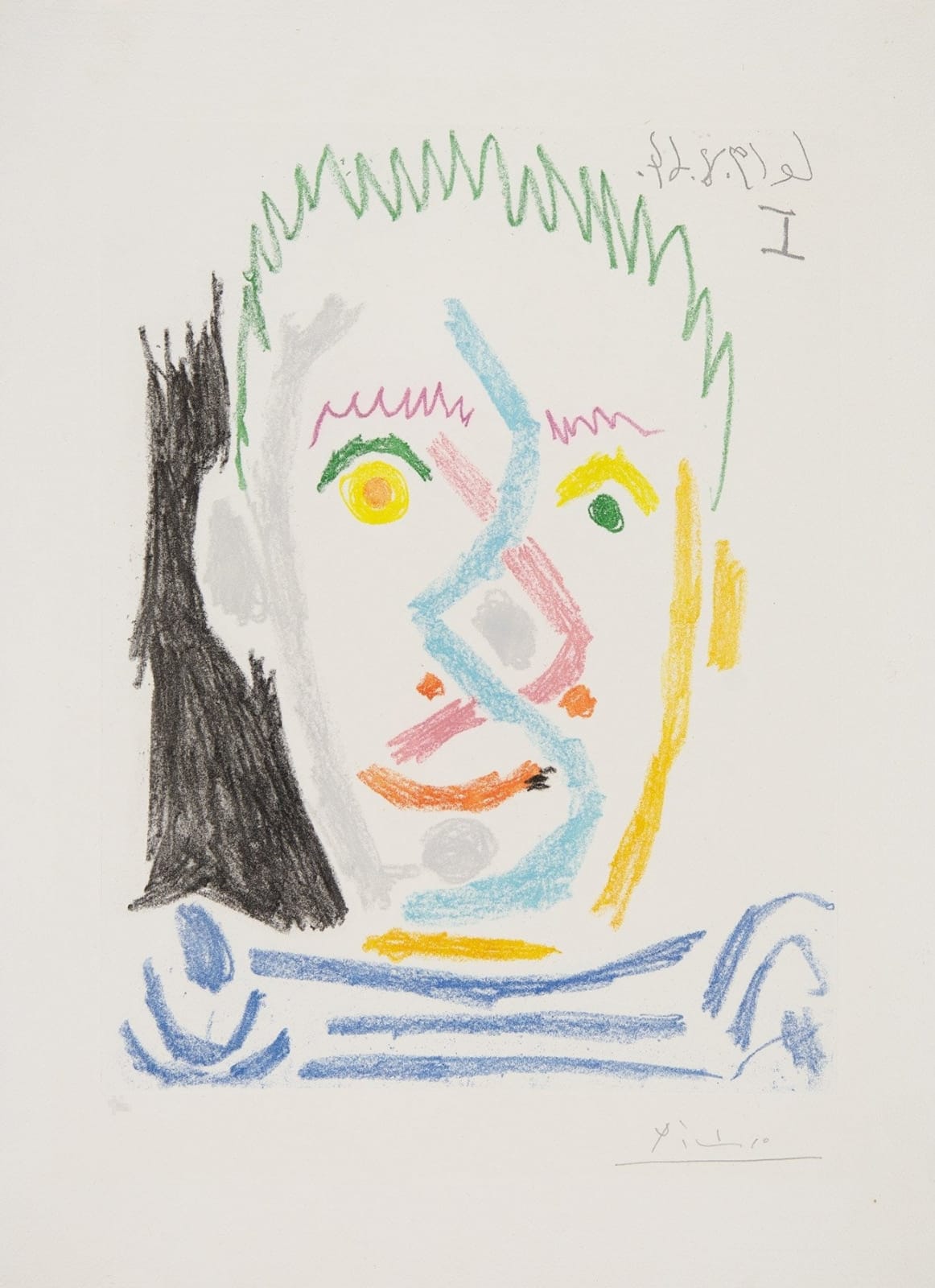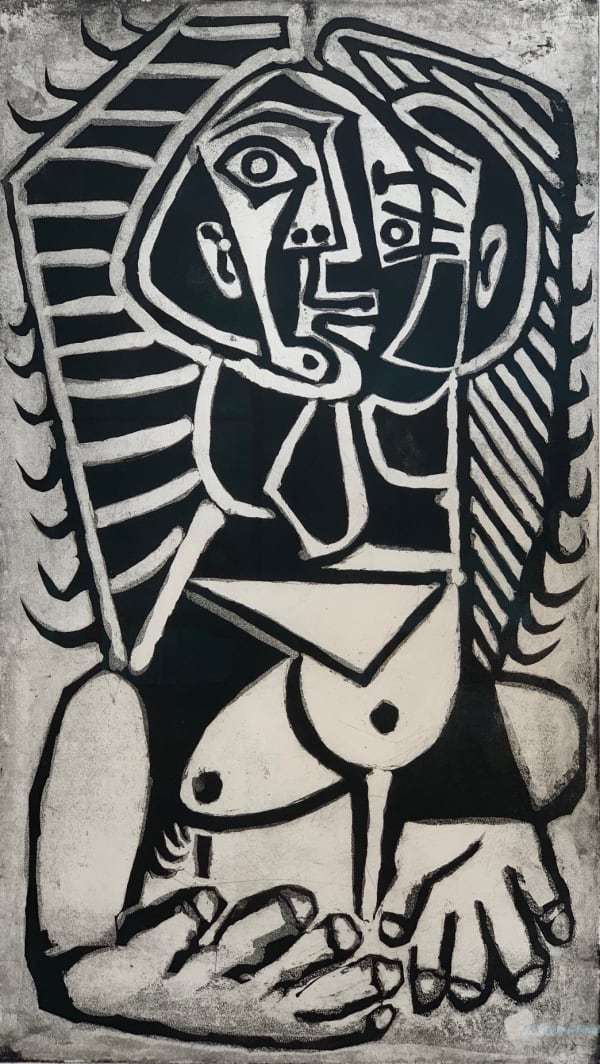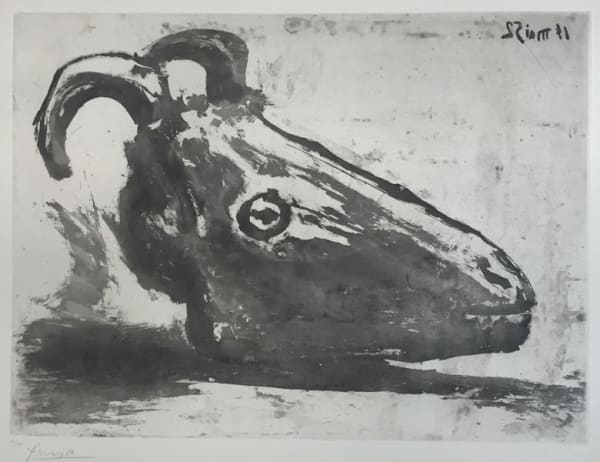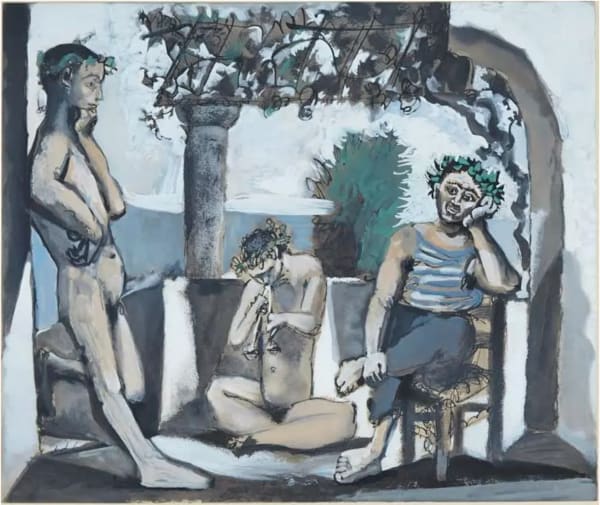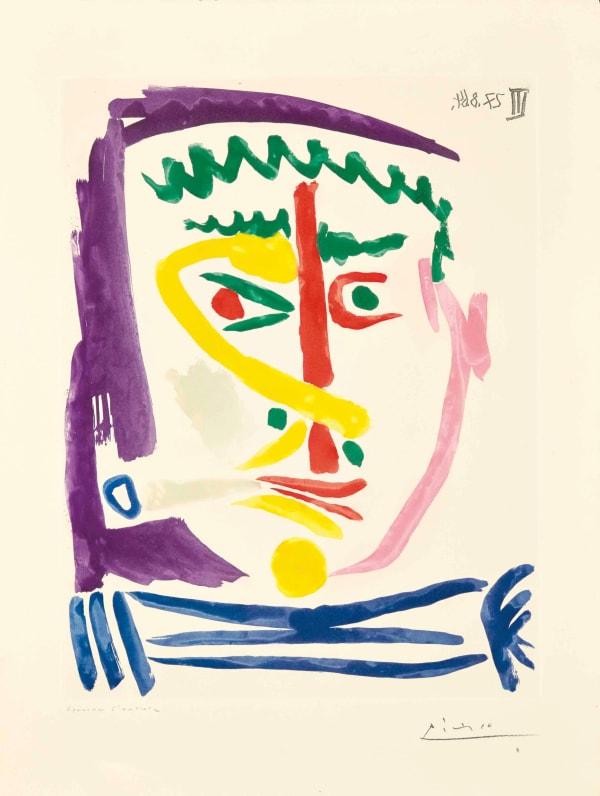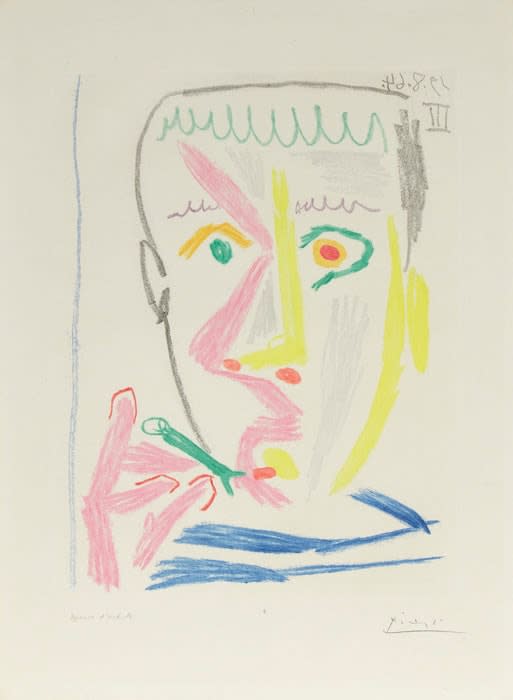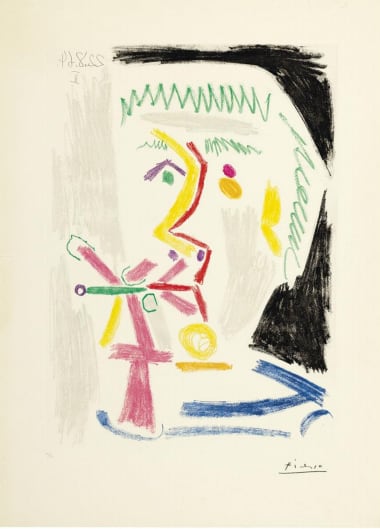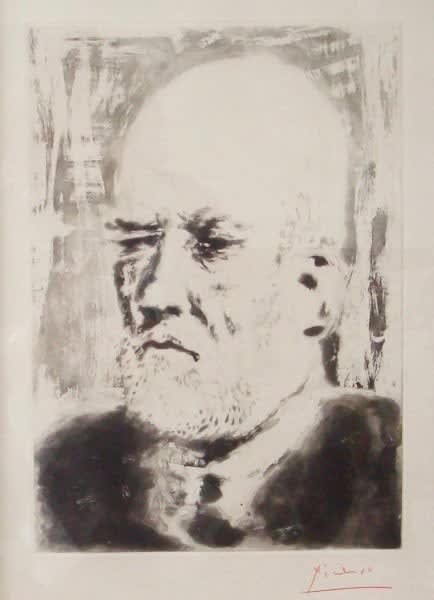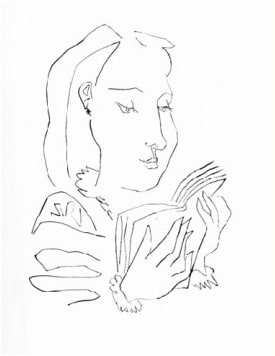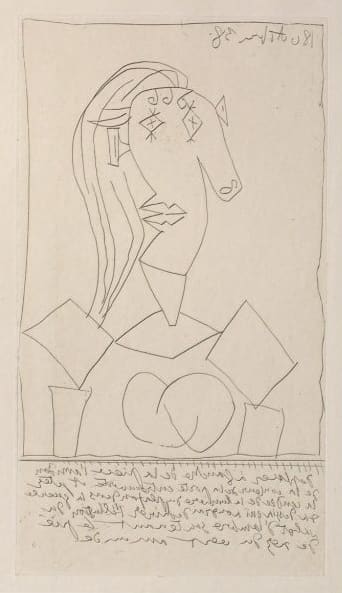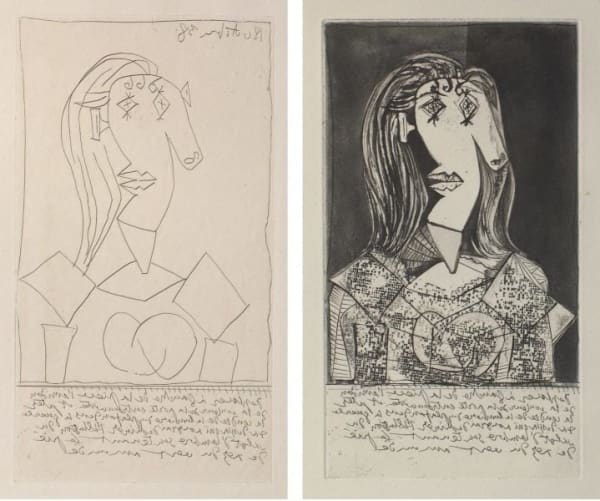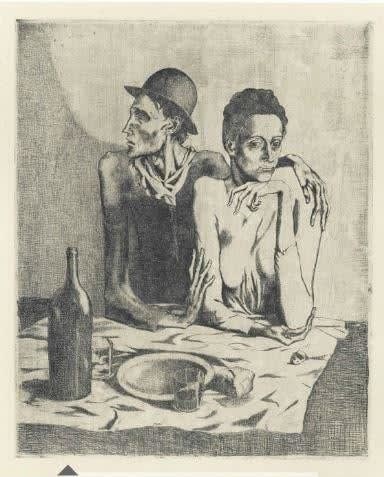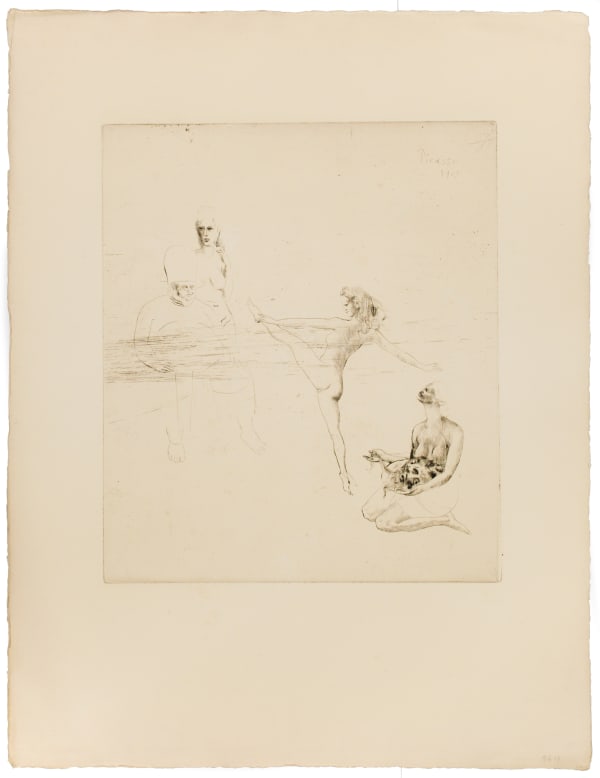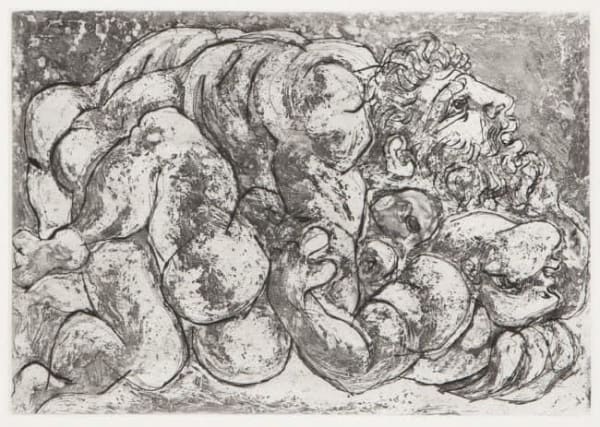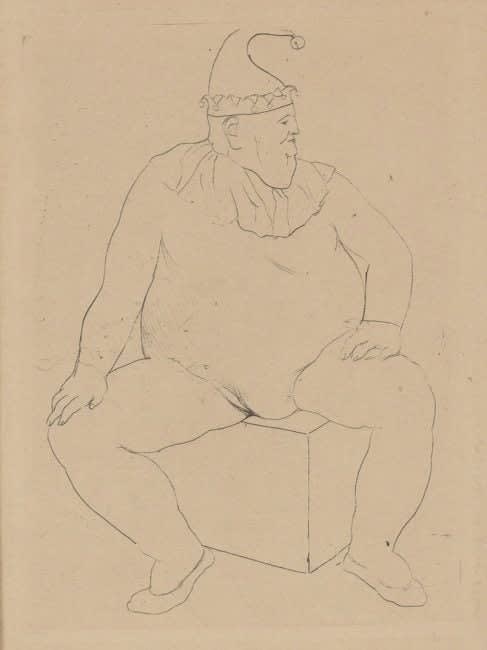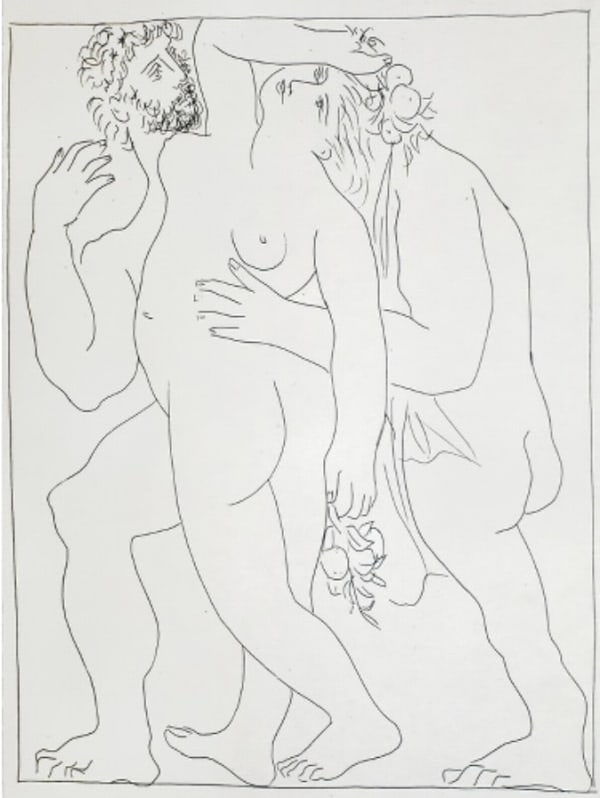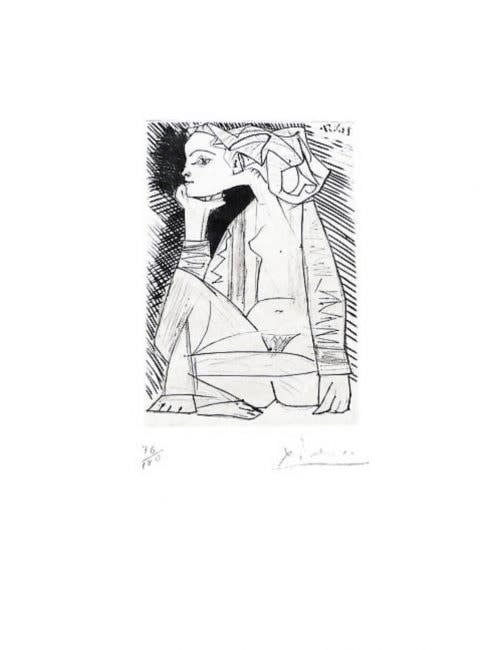-
Artworks

Pablo Picasso
Tête Homme au Maillot Rayé, 1964Color aquatint on Auvergene Richard de Bas paper.
Signed and numbered from the edition of 50 in graphite in the lower left margin; published by Galerie Louise Leiris, Paris; printed by Crommelynck, Paris.22 1/4 in x 16 1/4 in
56.5 cm x 41.3 cmEdition of 50Series: EtchingCopyright The ArtistHomme au Maillot Rayé (Man with the Striped Shirt) is a remarkable work from Pablo Picasso’s late period, created in 1964 when he was in his eighties. Using a combination...Homme au Maillot Rayé (Man with the Striped Shirt) is a remarkable work from Pablo Picasso’s late period, created in 1964 when he was in his eighties. Using a combination of etching and coloured crayon, this portrait exemplifies the dynamism, playfulness, and formal economy that defined Picasso’s approach to printmaking during his final decades. The portrait, at once bold and whimsical, reflects the artist’s enduring fascination with identity, self-representation, and the expressive potential of colour and line.
This highly stylised male head—frontal, mask-like, and full of colour—is rendered with an economy of gesture but bursting with vitality. A jagged line of electric blue diagonally divides the face, separating it into two halves—one marked by yellow and orange, the other by cool pastels and black. The asymmetry reinforces the Cubist principle of multiple perspectives, a concept Picasso returned to even in his most simplified works.
The eyes are differently treated: the left eye (on the viewer's right) is a stark black dot set in yellow, while the right eye is rendered as a swirling yellow-orange iris framed by green. The eyebrows, hair, and shirt are sketched in bold, crayon-like strokes, recalling a childlike sense of spontaneity. The palette is vivid—green, yellow, pink, blue, black, and orange—applied in unblended crayon strokes that seem almost impulsive, yet remain formally balanced.
The striped shirt at the bottom of the composition, composed of horizontal blue lines, reinforces the identity of the figure—likely a mariner or perhaps Picasso himself, as he often wore such shirts. The combination of bold colour blocks and linear features transforms the subject into a symbol rather than a direct likeness.
Picasso often explored the archetype of the “man in the striped shirt” in his late years—an image rooted in self-reflection, Mediterranean life, and his identification with sailors, poets, and outlaws. In this portrait, the sitter may represent Picasso himself or a timeless masculine figure distilled to pure graphic energy. The division of the face suggests psychological duality—youth and age, joy and tension, creation and contemplation.
There is a childlike quality to the execution that belies the sophistication of the composition. This duality—between innocence and mastery—is characteristic of Picasso’s late style, where formal looseness conceals deep structural harmony.
By the 1960s, Picasso was immersed in a prolific period of printmaking, especially in lithography, linocut, and etching. He collaborated extensively with printers like Aldo Crommelynck, constantly innovating new techniques and combining media. In works like Tête d’Homme au Maillot Rayé, he blurred the boundaries between drawing, painting, and print—treating the plate like a sketchbook page or a canvas.
Rather than striving for photographic realism or polished finish, Picasso prioritised directness of expression. His portraits of this era often celebrate graphic immediacy, emotion, and symbolic resonance.
Homme au Maillot Rayé exemplifies Picasso’s unique printmaking philosophy: treat every medium as a space of invention. Etching, traditionally associated with fine detail and laborious process, is here paired with expressive crayon lines—bridging the gap between the permanency of intaglio and the spontaneity of drawing.
The result is a portrait that is not a reproduction, but a living thing—vibrating with colour, movement, and character.
Tête d’Homme au Maillot Rayé is a vivid testament to Picasso’s genius in his final decades. With little more than a few lines and flashes of colour, he summons a presence that is both iconic and intimate. It is the work of an artist who, late in life, had nothing to prove but everything still to say—through colour, line, and the fearless spirit of invention.
For more information, contact our galleries via the inquiry form below.
%3Cdiv%20class%3D%22artist%22%3EPablo%20Picasso%3C/div%3E%3Cdiv%20class%3D%22title_and_year%22%3E%3Cspan%20class%3D%22title_and_year_title%22%3ET%C3%AAte%20Homme%20au%20Maillot%20Ray%C3%A9%3C/span%3E%2C%20%3Cspan%20class%3D%22title_and_year_year%22%3E1964%3C/span%3E%3C/div%3E%3Cdiv%20class%3D%22medium%22%3EColor%20aquatint%20on%20Auvergene%20Richard%20de%20Bas%20paper.%3Cbr/%3E%0ASigned%20and%20numbered%20from%20the%20edition%20of%2050%20in%20graphite%20in%20the%20lower%20left%20margin%3B%20published%20by%20Galerie%20Louise%20Leiris%2C%20Paris%3B%20printed%20by%20Crommelynck%2C%20Paris.%3C/div%3E%3Cdiv%20class%3D%22dimensions%22%3E22%201/4%20in%20x%2016%201/4%20in%20%3Cbr/%3E%0A56.5%20cm%20x%2041.3%20cm%3C/div%3E%3Cdiv%20class%3D%22edition_details%22%3EEdition%20of%2050%3C/div%3E%3Cdiv%20class%3D%22series%22%3E%3Cspan%20class%3D%22artwork_caption_prefix%22%3ESeries%3A%3C/span%3E%20Etching%3C/div%3ERelated artworks-
 Pablo PicassoTorse de Femme, 1953
Pablo PicassoTorse de Femme, 1953 -
 Pablo PicassoLe Crane de Chevre, 1952
Pablo PicassoLe Crane de Chevre, 1952 -
 Pablo PicassoNature Morte au Citron et au Pichet Rouge, 1955
Pablo PicassoNature Morte au Citron et au Pichet Rouge, 1955 -
 Pablo PicassoEcce Homo, d’Après Rembrandt, 1970
Pablo PicassoEcce Homo, d’Après Rembrandt, 1970 -
 Pablo PicassoCaricature of General de Gaulle and Two Women, from: Series 347| Caricature du général de Gaulle et deux femmes, 1968
Pablo PicassoCaricature of General de Gaulle and Two Women, from: Series 347| Caricature du général de Gaulle et deux femmes, 1968 -
 Pablo PicassoBacchanale, 1960
Pablo PicassoBacchanale, 1960 -
 Pablo PicassoFumer III, 1964
Pablo PicassoFumer III, 1964 -
 Pablo PicassoFumer , 1964
Pablo PicassoFumer , 1964 -
 Pablo PicassoL'Homme à la Guitare, 1915-29
Pablo PicassoL'Homme à la Guitare, 1915-29 -
 Pablo PicassoFumeur A La Cigarette Verte, 1964
Pablo PicassoFumeur A La Cigarette Verte, 1964 -
 Pablo PicassoPortrait of Vollard II, 1937
Pablo PicassoPortrait of Vollard II, 1937 -
 Pablo PicassoFemme Lisant, 1948
Pablo PicassoFemme Lisant, 1948 -
 Pablo PicassoBuste de Femme (Dora Maar) State I (Bloch 308), 1938
Pablo PicassoBuste de Femme (Dora Maar) State I (Bloch 308), 1938 -
 Pablo PicassoDora Maar, 1938
Pablo PicassoDora Maar, 1938 -
 Pablo PicassoLe Repas Frugal, 1904
Pablo PicassoLe Repas Frugal, 1904 -
 Pablo PicassoSalomé, 1905
Pablo PicassoSalomé, 1905 -
 Pablo PicassoAccouplement I, 1933
Pablo PicassoAccouplement I, 1933 -
 Pablo PicassoSaltimbanque au Repos (Bloch 10), 1905
Pablo PicassoSaltimbanque au Repos (Bloch 10), 1905 -
 Pablo PicassoTete de Femme, 1933
Pablo PicassoTete de Femme, 1933 -
 Pablo PicassoVertumne Poursuit Pomone de son Amour, 1930
Pablo PicassoVertumne Poursuit Pomone de son Amour, 1930 -
 Pablo PicassoFemme Assise en Tailleur, 1951
Pablo PicassoFemme Assise en Tailleur, 1951 -
 Pablo PicassoBuste de Femme (Dora Maar) State IX (Bloch 308), 1938
Pablo PicassoBuste de Femme (Dora Maar) State IX (Bloch 308), 1938
-
Join our mailing list
* denotes required fields
We will process the personal data you have supplied in accordance with our privacy policy (available on request). You can unsubscribe or change your preferences at any time by clicking the link in our emails.
This website uses cookies
This site uses cookies to help make it more useful to you. Find out more about cookies.
